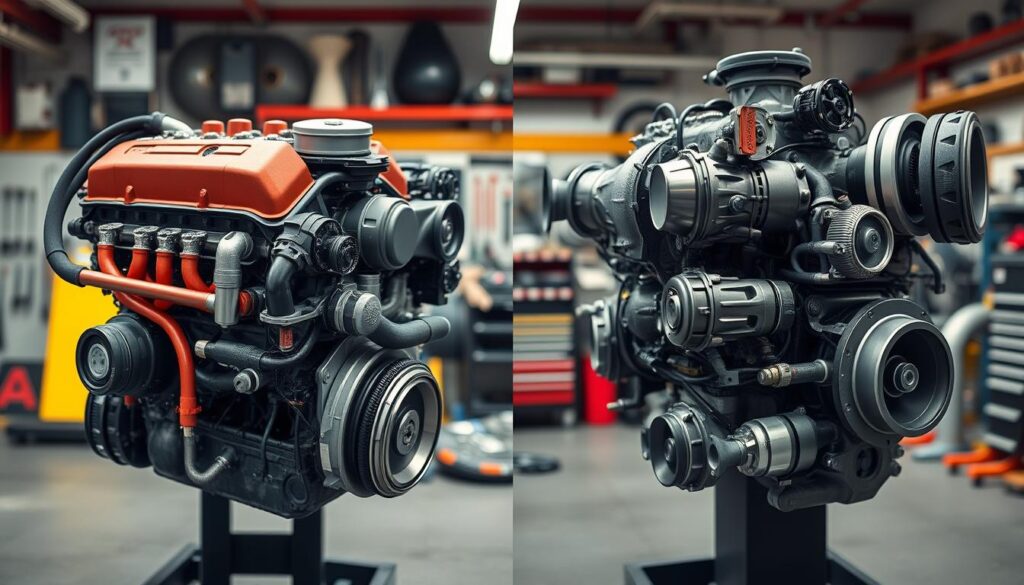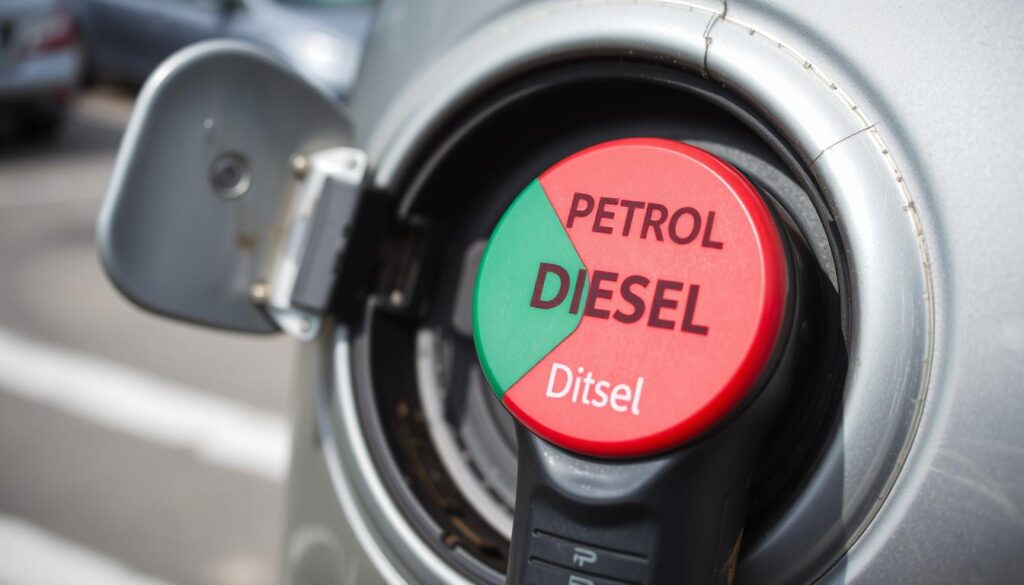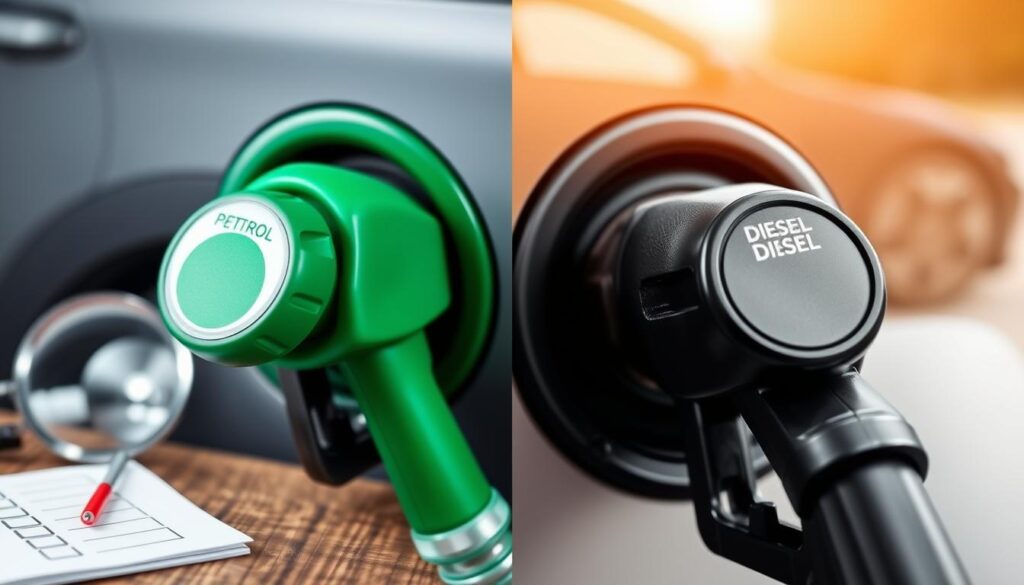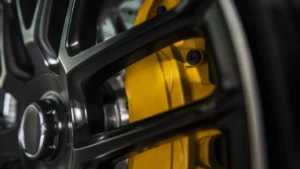Knowing if your car uses petrol or diesel is key to avoid big mistakes at the gas station. This article will show you simple ways to figure out your car’s fuel type. By understanding the difference between petrol and diesel engines, you can check your owner’s manual, emissions label, and fuel cap. This way, you’ll never accidentally put the wrong fuel in your car.

Key Takeaways
- Petrol and diesel engines have distinct combustion processes and engine configurations
- Checking the owner’s manual is the most reliable way to determine your vehicle’s fuel type
- The emissions label and fuel filler cap can also provide clues about the fuel type
- Listening to the engine’s sound and inspecting service records are additional methods to identify fuel type
- Knowing your car’s fuel type is essential to prevent expensive engine damage from using the wrong fuel
Understanding the Difference Between Petrol and Diesel Engines
Petrol and diesel engines may look the same, but they work differently inside. Knowing how each engine works helps us understand their unique features.
Combustion Process
Petrol engines use a spark plug to start the air-fuel mix. Diesel engines ignite fuel with compression heat. This makes diesel engines more efficient and powerful.
Engine Configuration
Petrol and diesel engines also have different setups. Diesel engines have a special cylinder arrangement and fuel system. They have a longer stroke and higher compression, leading to more combustion sound and power.
| Characteristic | Petrol Engine | Diesel Engine |
|---|---|---|
| Combustion Process | Spark-ignited | Compression-ignited |
| Compression Ratio | 8:1 to 11:1 | 16:1 to 25:1 |
| Fuel Injection | Carburetor or fuel injection | Direct fuel injection |
| Engine Configuration | Shorter stroke | Longer stroke |
It’s important to know the differences between petrol and diesel engines. This helps you choose the right vehicle for your needs and driving style.
Checking the Vehicle Owner’s Manual
The owner’s manual is the best place to find out your vehicle’s fuel type. It’s given by the manufacturer and has all the details about your car. This includes the fuel type your engine needs.
By looking at the “Specifications” or “Fuel” section, you can find out if your car uses petrol or diesel. The manual might also tell you about the fuel’s octane or cetane rating. It could also give tips on refueling.
It’s smart to keep your owner’s manual handy. It’s a reliable source for many car-related questions. By using this guide, you can make sure you’re using the right fuel and taking care of your car as the maker suggests.
“The owner’s manual is your vehicle’s instruction manual – it’s the best resource for understanding your car’s specific requirements and capabilities.”
The manual might also have info on maintenance, troubleshooting, and safety. Knowing what’s in it can make you a better car owner. It helps you take care of your vehicle properly.
Identifying Fuel Type from the Emissions Label
The emissions label can help you figure out if your car uses petrol or diesel. You can find this label in the engine bay or on the driver’s side door jamb. It clearly shows the fuel type your car is meant for.
Location of the Emissions Label
The emissions label is often in two places on your vehicle:
- In the engine bay, near the firewall or under the hood
- On the driver’s side door jamb, where the door meets the car’s body
Reading the Fuel Type Information
After finding the emissions label, you can see the fuel type info. It’s usually shown in a simple way, like:
| Fuel Type | Indicator |
|---|---|
| Petrol | Gasoline |
| Diesel | Diesel |
By looking at the emissions label, you can quickly find out if your car needs petrol or diesel. This makes sure you fill up with the right fuel type information.
Inspecting the Fuel Filler Cap
Looking at the fuel filler cap can tell you if your car uses petrol or diesel. The cap often shows the fuel type your car needs.
Check the fuel filler cap for the words “Petrol” or “Diesel.” This label makes it easy to know what fuel type your car needs.
Even without labels, the cap’s size can give clues. Diesel fuel filler caps are usually bigger than petrol caps. This helps prevent putting the wrong fuel in a car.
“The fuel filler cap is a simple but important clue in determining your car’s fuel type.”
By looking at the fuel filler cap, you can quickly find out if your car needs petrol or diesel. This helps you avoid mistakes that can cost a lot and damage your car.

Recognizing the Fuel Gauge Symbol
The fuel gauge symbol in your car can help you know what fuel type it uses. It shows a specific symbol in the instrument cluster. This symbol tells you if your car uses petrol or diesel.
Petrol Fuel Gauge Symbol
Petrol cars usually have a fuel pump icon on the gauge. This symbol makes it clear your car uses petrol, or gasoline in the US.
Diesel Fuel Gauge Symbol
Diesel cars have a fuel pump icon with a “D” next to it. This mark shows your car needs diesel fuel. Diesel works differently than petrol.
Knowing the fuel gauge symbol in your car can prevent wrong fuel mistakes. Spotting these symbols ensures you fill up with the right fuel type identification. Whether it’s fuel gauge symbol for petrol or diesel, it’s important.
how to check if a car is petrol or diesel
Knowing your car’s fuel type is key to avoid expensive mistakes at the gas station. There are several ways to find out if your car uses petrol or diesel. By following these easy steps, you can know for sure what fuel your car needs.
Consult the Owner’s Manual
The best way to know your car’s fuel type is to check the owner’s manual. This document from the manufacturer will tell you if your car needs petrol or diesel. Always refer to the owner’s manual if you’re unsure.
Inspect the Emissions Label
Look at the emissions label on your car. It’s usually on the driver’s side door jamb or the engine bay. This label will clearly say if your car uses petrol or diesel, helping you choose the right fuel.
Examine the Fuel Filler Cap
Check the fuel filler cap on your car. Petrol cars have a smaller filler neck, while diesel cars have a larger cap. This can quickly tell you what fuel your car needs.
Recognize the Fuel Gauge Symbol
The fuel gauge on your dashboard can also give a hint. Petrol cars show a fuel pump symbol, while diesel cars have a symbol with “D” or “Diesel”. Knowing these symbols helps you identify the fuel type easily.
By using these methods, you can check if a car is petrol or diesel and fuel it correctly. This saves you time, money, and the trouble of putting the wrong fuel in your car.

Listening to the Engine’s Combustion Sound
Listening to your car’s engine can help figure out its fuel type. Diesel engines make a louder, more distinct sound than petrol engines. This is because diesel engines burn fuel differently.
But, this method isn’t always reliable. Engine sounds can change based on many things like engine size and driving conditions. For example, a big diesel engine might sound like a smaller petrol engine.
- Listen closely to the engine, especially when it’s working hard.
- Diesel engines usually have a louder, “knocking” sound. Petrol engines are smoother and quieter.
- Remember, many things can affect engine sounds. So, use this method with caution.
“The combustion sound is a useful clue, but it shouldn’t be the sole basis for determining the fuel type of your vehicle.”
The engine’s combustion sound can give some hints about the fuel type identification. But, it’s best to use other methods too. Check the owner’s manual, fuel filler cap, or emissions label to be sure.
| Fuel Type | Typical Engine Sound |
|---|---|
| Petrol | Smoother, quieter operation |
| Diesel | More pronounced, louder “knocking” or “thumping” sound |
Checking Service Records for Fuel Type
If you have your vehicle’s service records, you can find out what fuel it needs. These records, from the dealership or your own logs, show the fuel type for your car. They are key for keeping your car running well.
Service Records at Dealerships
Dealerships keep detailed service records for cars they sell. These records list the car’s maintenance history. They show the fuel type your car needs, which dealerships track closely.
By looking at your car’s service records from the dealership, you can find out the right fuel type.
Personal Service Records
- Keeping your own service records helps you know your car’s fuel type.
- Check for any mentions of fuel type in oil changes or tune-ups.
- Good service records are a reliable way to find your car’s fuel type.
| Fuel Type | Advantages | Disadvantages |
|---|---|---|
| Petrol | Higher engine performance Easier to find at gas stations Generally cheaper than diesel | Lower fuel efficiency Higher emissions |
| Diesel | Better fuel efficiency Lower emissions | Higher maintenance costs Louder engine noise |
Looking at your car’s service records helps you know the best fuel type. This ensures your car runs well and efficiently.
“Keeping detailed service records is key to knowing your car’s fuel needs. It helps keep your car healthy for a long time.”
Conclusion
Knowing your car’s fuel type is key to avoiding expensive mistakes. This article shows you how to tell if your car uses petrol or diesel. You can check the owner’s manual or look for the fuel gauge symbol.
It doesn’t matter if you’re new to driving or have been doing it for years. Knowing the difference between petrol and diesel engines is vital. It helps keep your car running well and lasts longer.
Identifying your car’s fuel type is a small but important step. By following the tips in this article, you can make sure your car gets the right fuel. This way, your car will run smoothly and efficiently for many years.
FAQ
How can I determine if my car runs on petrol or diesel?
You can check your car’s fuel type in several ways. Look in the owner’s manual, check the emissions label, and examine the fuel filler cap. You can also look for the fuel gauge symbol.
Where can I find information about my car’s fuel type in the owner’s manual?
The owner’s manual is the best place to find your car’s fuel type. It will clearly say if your engine uses petrol or diesel. This makes it the easiest way to know what fuel you need.
How can the emissions label help me identify the fuel type?
The emissions label, found in the engine bay or on the driver’s side door jamb, is very helpful. It will tell you if your car uses petrol or diesel fuel.
What can the fuel filler cap tell me about the fuel type?
Look closely at your car’s fuel filler cap. It might show the fuel type or have a different size than petrol caps. Diesel caps are usually larger to prevent putting in the wrong fuel.
How can the fuel gauge symbol help me identify the fuel type?
The fuel gauge in your car’s dashboard might have a symbol for the fuel type. Petrol cars have a fuel pump icon, while diesel cars have a similar icon with a “D” next to it.
Can the engine’s combustion sound help me determine the fuel type?
The engine sound can give you a hint about the fuel type. Diesel engines are usually louder and more pronounced than petrol engines. But, this method isn’t always reliable because engine sounds can change for many reasons.
How can I use my car’s service records to identify the fuel type?
Your car’s service history can also tell you the fuel type. Check the records from the dealership or your own maintenance logs. They should clearly state if your car needs petrol or diesel.






